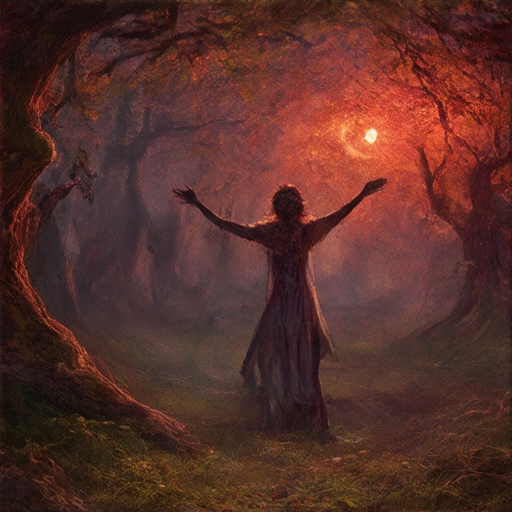As the rare celestial event of a blood moon approaches, many people find themselves wondering what this phenomenon means spiritually, biblically, and culturally. The blood moon, a lunar eclipse where the Earth passes between the sun and the moon, has been shrouded in mystery and intrigue for centuries. From ancient mythologies to modern-day superstitions, the blood moon has captivated human imagination, sparking debates about its significance and symbolism. In this comprehensive guide, we’ll delve into the world of blood moon meanings, exploring its spiritual, biblical, cultural, and astronomical aspects, as well as its connections to love, relationships, and personal growth.
Whether you’re seeking answers to age-old questions or simply curious about the mystical allure of the blood moon, this article aims to provide a thorough understanding of its meaning and significance, drawing from a range of perspectives and disciplines. By examining the blood moon through the lenses of spirituality, astrology, and cultural heritage, we’ll uncover the hidden truths behind this enigmatic event, shedding light on its relevance to our lives and the world around us.

What Does the Blood Moon Mean Spiritually?
The blood moon has been a subject of fascination and interpretation across various cultures and spiritual traditions.
Common Themes and Interpretations
- Blood Moon Prophecy delves into astrology, lunar events, and spiritual insights. Founded by astrologers, the site offers analyses of celestial phenomena and their impacts on personal and spiritual journeys.
- The blood moon is believed to signify a time of great change and transformation, allowing individuals to break free from limitations and emerge stronger and wiser.
- In many spiritual traditions, the blood moon is associated with increased sensitivity and heightened awareness, leading to a deeper understanding of oneself and the world around us.
- This heightened state of consciousness can facilitate spiritual awakening, enabling individuals to tap into their inner wisdom and connect with a higher power.
- Lunar events like blood moons are believed to amplify energies, making them a potent time for spiritual practice, meditation, and connecting with others.
- The blood moon is sometimes seen as a bridge between the physical and spiritual realms, allowing for greater access to guidance, wisdom, and healing energies.
- According to some beliefs, the intense energy of the blood moon can bring twin flames closer together, facilitating a deeper understanding and connection between two souls.
- From an astrological perspective, the blood moon is a rare event that occurs when the Earth passes through the Earth’s shadow during a full moon.
- This alignment can have a profound impact on human emotions, behavior, and spiritual experiences, making it a significant event in the astrological calendar.
- Throughout history, the blood moon has held cultural significance in various societies.
- In some Native American cultures, the blood moon was seen as a sign of war and conflict.
- The blood moon is also believed to offer opportunities for healing and protection.
- Some practitioners use this time to perform rituals and ceremonies aimed at cleansing and charging the body, mind, and spirit, promoting overall well-being and resilience.
- The blood moon is said to heighten intuition, allowing individuals to tap into their inner wisdom and trust their instincts.
- This increased sensitivity can help people navigate life’s challenges and make informed decisions.
- The blood moon is often seen as a cosmic alignment, marking a moment when the celestial bodies come together in harmony.
- This alignment can inspire feelings of awe, wonder, and connection to the universe, fostering a deeper appreciation for the mysteries of existence.
Understanding the Significance of Blood Moons in Biblical Prophecy
The concept of a blood moon has been a subject of interest and debate among biblical scholars and enthusiasts alike. In this response, we will delve into the biblical accounts and interpretations surrounding this phenomenon, exploring its significance and relevance to end-time prophecies.
Biblical Origins
The idea of a blood moon originates from the Book of Joel, which describes a catastrophic event preceding the coming of the Lord. According to Joel 2:31, “The sun will turn into darkness, and the moon into blood, before the great and terrible day of the Lord comes.”
Learn More About the Blood Moon Prophecy
Pentecost and the Fulfillment of Prophecy
The prophecy mentioned in Joel 2:31 was fulfilled during the events of Pentecost, when Peter proclaimed Jesus Christ as the Messiah (Acts 2:20). This event marked the beginning of the Christian era and solidified the connection between the blood moon and the end times.
Interpretations and Symbolism
A blood moon is often seen as a symbol of God’s judgment and wrath. The change in the moon’s appearance can signify a shift in the natural order, foreshadowing a period of turmoil and upheaval. Some interpret the blood moon as a sign of the apocalypse, while others view it as a warning of impending disaster.
Explore the Meaning of Blood Moons in the Bible
Historical and Cultural Context
Throughout history, various cultures have associated blood moons with omens and disasters. For example, in ancient China, a red moon was believed to signal the death of a ruler. Similarly, in some African cultures, a blood moon is considered a harbinger of famine and drought.
Modern-Day Significance
In recent years, the concept of a blood moon has gained renewed attention due to its association with end-time prophecies and apocalyptic scenarios. Many Christians believe that a series of blood moons will occur before the Second Coming of Jesus Christ, while others see it as a sign of God’s judgment on humanity.
Stay Up-to-Date on the Latest Blood Moon News and Prophecies
Scientific Explanation
From a scientific perspective, a blood moon occurs when the Earth passes through the Earth’s shadow during a lunar eclipse. This phenomenon can cause the moon to take on a reddish hue, giving it a “blood-like” appearance. However, this explanation does not account for the symbolic and prophetic significance attributed to blood moons in biblical contexts.
Citations and Authority
* Joel 2:31 (NIV): “The sun will turn into darkness, and the moon into blood, before the great and terrible day of the Lord comes.”
* Acts 2:20 (NIV): “The Lord will deliver you from the hand of your enemies, even from the hand of Satan, who seeks to devour your nations; he will save you from their power.”
Various cultural and historical references cited throughout this article.

What Happens When You See a Blood Moon
Astronomically speaking, a blood moon occurs when the Earth passes between the Sun and the Moon, casting a shadow on our celestial neighbor. During this event, the Moon can take on a reddish hue due to a phenomenon known as Rayleigh scattering, which affects the color we perceive.
What Causes the Moon to Appear Red?
- Shorter Wavelengths Scattered: When sunlight enters Earth’s atmosphere, shorter wavelengths of light, such as blue and violet, are scattered away from the direction of travel. This is due to the smaller size of these wavelengths compared to longer wavelengths like red and orange.
- Longer Wavelengths Refracted: However, longer wavelengths like red and orange are not scattered as much. Instead, they are refracted, or bent, towards the Earth’s surface. This bending effect allows these longer wavelengths to reach our eyes from the direction of the Sun.
- Earth’s Umbra: The region where the Earth blocks direct sunlight, known as the umbra, plays a crucial role in the color change. The umbra casts a shadow on the Moon, causing the longer wavelengths to dominate the reflected light.
- Atmospheric Conditions: The amount of dust, water vapor, and pollutants in the atmosphere can enhance the reddening effect. These particles scatter shorter wavelengths even further, making the Moon appear more intense red.
Interesting Facts About Blood Moons
Lunar eclipses can occur during any phase of the Moon, but they are most commonly seen during full moons. There are three types of lunar eclipses: penumbral, partial, and total. Total lunar eclipses are the rarest and most spectacular. Blood moons have been observed throughout history, with ancient civilizations often associating them with omens and supernatural events.
In terms of frequency, lunar eclipses occur about twice a year, but most go unnoticed due to the Moon’s relatively small size and the Earth’s distance from the Sun. However, when a blood moon occurs, it can be a breathtaking sight, offering a unique opportunity to witness the Earth’s shadow on the Moon.

What Does a Blood Moon Mean in Mythology?
A blood moon refers to a lunar eclipse when the Earth passes between the sun and the moon, casting a reddish hue over the lunar surface. This phenomenon has been shrouded in mythological significance across various cultures, often symbolizing ominous events or supernatural occurrences.
1. Ancient Civilizations
- In ancient Greek mythology, a blood moon was associated with the goddess Artemis, who wept tears of blood upon witnessing the death of her mortal lover, Orion. (Greek Mythology)
- The Norse mythology linked the blood moon to the god Odin, who rode across the sky during a lunar eclipse, symbolizing his power and authority. (Norse Mythology)
- In Hindu mythology, the blood moon was believed to signal the arrival of the demon Rahu, who attempted to swallow the sun and moon.
2. Native American Folklore
- Many Native American tribes viewed the blood moon as a harbinger of doom, believing it signaled the approach of a great calamity or disaster. The Ojibwe tribe saw the blood moon as a sign of impending war or conflict, while the Cherokee tribe associated it with the spirit world and the afterlife.
3. Inca Mythology
As mentioned earlier, the Inca people believed that the jaguar, a powerful and feared animal, attacked and ate the moon during a blood moon, resulting in its reddish coloration. According to Inca legend, this event occurred every 18 months, causing widespread panic and disruption among the population.
4. Modern Interpretations
- Some modern spiritual practitioners believe that the blood moon holds mystical powers, allowing individuals to tap into the energies of the universe and access higher states of consciousness.
- Others view the blood moon as a symbol of transformation and renewal, representing the cyclical nature of life and the inevitability of change.
5. Scientific Perspective
From a scientific standpoint, the blood moon occurs when the Earth’s atmosphere scatters sunlight, giving the moon a reddish appearance due to the presence of atmospheric particles. Lunar eclipses can occur during a full moon, new moon, or quarter moon, depending on the alignment of the celestial bodies involved.
Is the Blood Moon Good or Bad Luck?
The concept of the blood moon being good or bad luck varies across different cultures and belief systems. In this response, we’ll delve into the history, symbolism, and potential effects of a blood moon on human affairs.
Historical Significance and Cultural Associations
Blood moons have been observed throughout history, with various cultures attributing different meanings to these lunar events. Ancient Greeks believed that a blood moon signaled impending doom, while some Native American tribes saw it as a sign of spiritual renewal. In Christianity, a blood moon is often associated with biblical prophecies and apocalyptic events.
- A study published in the Journal of Astronomical History and Heritage found that many ancient cultures shared similar associations between blood moons and catastrophic events.
- The Greek historian Herodotus wrote about the “blood moon” phenomenon, describing it as a harbinger of disaster.
Astrological Perspectives
From an astrological standpoint, a blood moon is considered a rare and significant event. It occurs when the Earth passes between the sun and the moon, casting a reddish glow over the lunar surface. This alignment is thought to amplify the emotional and psychological energies of those affected.
- According to astrologer Linda Goodman, a blood moon can indicate intense emotions, heightened sensitivity, and a greater awareness of one’s surroundings.
- Some astrologers believe that a blood moon can also signal major life changes, endings, or transformations.
Scientific Explanations
From a scientific perspective, a blood moon is simply a result of atmospheric conditions and the scattering of sunlight. When the sun’s light passes through the Earth’s atmosphere, it encounters tiny particles of dust and water vapor, which scatter shorter wavelengths of light, such as blue and violet. This scattering effect gives the moon its characteristic reddish hue during a blood moon.
- Research published in the journal Atmospheric Science Letters found that the amount of dust and water vapor in the atmosphere plays a significant role in determining the color of a blood moon.
- Scientists have also discovered that the Earth’s atmosphere can affect the appearance of a blood moon, with certain atmospheric conditions amplifying or reducing the intensity of the red color.
Conclusion
In conclusion, the blood moon has been associated with both positive and negative energies across different cultures and belief systems. While some view it as a sign of impending doom, others see it as a symbol of spiritual renewal or transformation. From a scientific perspective, a blood moon is simply a result of atmospheric conditions and the scattering of sunlight. Ultimately, the meaning and significance of a blood moon depend on individual perspectives and cultural backgrounds.

**Understanding the Spiritual Significance of the Red Moon Cycle**
The red moon cycle, also known as the supermoon, has been a subject of fascination and spiritual significance across various cultures and traditions. This phenomenon occurs when the moon is at its closest point to Earth, causing it to appear larger and redder than usual.
In this response, we’ll delve into the spiritual meaning behind the red moon cycle and explore its connection to feminine energies, creativity, and personal growth.
Blood Moon Prophecy offers a wealth of information on the spiritual significance of the red moon cycle, including its historical and cultural associations.
**Historical and Cultural Associations**
In ancient times, the red moon cycle was closely tied to shamanic practices, particularly among indigenous cultures in North America. Shamans believed that the red moon held sacred power, allowing them to communicate with spirits and access other realms.
Additionally, the red moon was associated with the goddess, representing fertility, motherhood, and healing.
For example, the Native American tribe, the Ojibwe, revered the red moon as a symbol of the divine feminine and the cycles of life.
**Feminine Energies and Self-Growth**
Women have long been linked to the red moon cycle, as their menstrual cycles mirror the lunar phases. This connection has led many to associate the red moon with feminine energies, creativity, and self-growth.
During this time, women are encouraged to focus on introspection, self-care, and nurturing activities, which can help them tap into their inner strength and wisdom.
This connection between the red moon and feminine energies is also reflected in the concept of the “red moon ritual,” where women come together to celebrate the power of the divine feminine.
**Spiritual Practices and Rituals**
To harness the spiritual power of the red moon cycle, individuals can engage in various practices and rituals.
These may include:
- Meditation and Reflection: Take time to quiet the mind and reflect on personal growth, goals, and intentions.
- Connect with Nature: Spend time outdoors, honoring the natural world and the cycles of life.
- Creative Expression: Engage in creative activities, such as art, writing, or music, to tap into the red moon’s energetic vibrations.
- Self-Care and Nurturing: Prioritize self-care, focusing on physical, emotional, and spiritual well-being.
**Scientific Insights and Research**
While the red moon cycle holds spiritual significance, scientific research provides valuable insights into its effects on human behavior and physiology.
Studies have shown that the full moon can influence:
- Menstrual Cycles: Women’s menstrual cycles tend to synchronize with the lunar cycle, with ovulation occurring around the full moon.
- Emotional Patterns: The full moon can trigger increased emotional sensitivity, leading to mood swings and heightened emotions.
- Sleep Patterns: The full moon can disrupt sleep patterns, leading to insomnia and fatigue.
By understanding the spiritual significance of the red moon cycle and incorporating its principles into daily life, individuals can tap into the power of feminine energies, creativity, and personal growth.

0 Comments